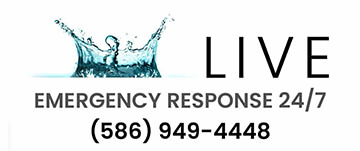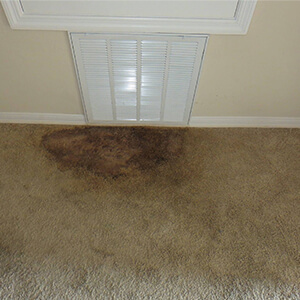6 Steps To Remove Water From Carpet And Prevent Mold Growth
Wet carpet is almost always immediately noticed as wet, whether you are wearing socks, shoes or barefoot. The source of the water will vary from a leak to an overflow or even an appliance that has malfunctioned.
Have you discovered wet carpet after descending your steps to a wet basement? Has a drain backed up damaging your valued floor covering? Anyone who has experienced this will attest to the inescapable conclusion that, “this is a bad thing”.
If wet carpets are discovered moments after the intrusion than chances are your situation is not as grim as those who stumble upon the same event after being away for a weeks’ vacation.
Do You Have A Water Issue That Has Affected Your Carpet?
You are not alone as most insurance claims are related to in home water emergencies. However, in many cases a professional restoration firm may not be required if the water is isolated. The situation is manageable in many cases with a little knowhow and commitment to remedying the problem the right way.
Wet carpet left to itself can create a menacing situation where subfloors become permanently damaged, smells manifest and even mold growth can begin. Following the steps below will assure that these unpleasant developments don’t occur in your home.
Finding The Source Of The Water
While it may appear obvious like a leaky pipe or appliance that has malfunctioned, sometimes why carpet is wet can be a conundrum. Be sure to look at all nearby plumbing from kitchens and bathrooms. If the area is in a basement locate where floor drain may be located. Investigate the surrounding areas by your water heater and humidifier too if your home has one.
Sometimes the source of moisture can be overhead so look for signs of water stains or water coming down through the ceilings. Plumbing in the walls and/or ceilings that may be the source often leak in stealth making it difficult to locate.
Lastly check by walls and corners that are not frequently walked on as in some cases water is slowly infiltrating from outside the home making its way to your carpet. Sometimes a pungent smell that has pervaded the home will be worse near the source and indicate the reason why carpet is wet.
Sometimes Carpet Is Wet And You Don’t Know
While this may seem counterintuitive to believe carpet is wet when it doesn’t feel wet, it is more common than you might think. How? You may ask. Many carpets have a pad that has a plastic top cover to keep spills and pet accident from getting to the actual pad. These pads are sometimes called spill guard and water proof. In cases where water comes down from the top these plastic liners may help prevent water from getting to the pad. Conversely any water (from a drain, floor crack or slow leak) coming from the bottom up will be trapped in pad as the plastic liner will keep it from getting to the top.
Several signs this is occurring will be pungent smells, vacuuming the area feels noticeably different than other areas vacuumed, discoloration slowly appears and gets bigger each week. The worse signs are when health issues occur such as itchy eyes and throat, coughing, allergy like symptoms and a mysterious malaise that doesn’t seem to go away.
In such circumstances it is advisable to contact a professional water restoration firm to assist. There exist the potential of a high risk environment requiring stringent guidelines to keep the possible presence of mold from spreading.
6 Steps To Remove Water From Carpet And Prevent Mold Growth
If your carpet is wet, smells and you have taken care of the source, there’s no time to lose. Follow these 6 steps for water removal and drying your carpet. Proper and careful adherence to these guidelines can prevent the growth and spread of mold and mildew.
1. Remove The Water And Moisture
Most homes have a shop vac somewhere that can be operated as a wet vac and are ideal for removing water from carpets. Vacuum is the best way to extract surface water and minimize the moisture content allowing for the drying process to begin.
If you don’t have a wet vac than chances are your neighbor does and the two of you are on speaking terms and friendly. If they are nice enough to loan you the use of their vacuum I would suggest buying them a new filter as a way of saying thank you.
If the neighbor suggestion doesn’t work out than any hardware store sells affordable shop/wet vacs and there uses in the home or garage are many. In some cases they may even rent them if you’re not convinced you would need one in the future.
2. Check Your Walls And Furniture For Moisture
For the same reason the carpets are wet you may also have wet walls or furniture. When carpet gets wet it can absorb and spread to a walls base molding and dry wall. These materials are cellulose and serve as a food source for mold. Once they become wet they can produce mold if not dried quickly.
Evaluating these materials for moisture is essential if you want to ward off all possibilities for mold. If moisture is discovered in the base or dry wall, place a fan for 2-3 days to dry the wet materials.
The same should be done for furniture in the area as well. Check to see if they are noticeably wet or signs of moisture are present. In some cases you may find mold has already begun to grow on wood legs or on fabrics. If this is discovered it is important to remove these items from your home as mold spores will continue to increasingly spread.
3. Create Air Flow With Fans
Once you remove water there will still remain moisture you must contend with. Just like wet clothing left in the washing machine after the spin cycle (water removal process) will smell and potentially mildew, so will your carpet.
Placing a fan or two for at least 2 days will create the necessary air movement energy to dry. Rapid air flow forces moisture to become a vapor forcing the wet materials to become dry and safe from molds potential. Mold can only begin and spread in a moist conducive environment. Air movement from fans and opening windows will serve as a hostile environment for mold, keeping you and your family safe.
In some instances if the amount of water was great and the area large you may need the energy of multiple air movers. In such conditions it is recommended to utilize high-powered fans that you may not actually possess. Consider renting them from a hardware store or tool rental place for at least 2 days and monitor the drying progress.
If you had a lot of water that means after the water extraction process you will still have a lot of moisture to remove. The multiple high-powered fans will be sufficient to force the moisture to evaporate into a vapor, which is exactly what you want. If the weather is seasonably warm that open a few windows to allow the excessive humidity to evacuate from your property. If this is not an option you may want to place a dehumidifier in the room to help remove the excessive humidity.
4. Evaluate and Consider Replacing the Carpet Padding
In some cases the amount of water is minimal and the above steps will be sufficient to fully restore the water damaged area. In some instances though, the wet pad could still be an issue and needs to be dealt with accordingly. Here are 2 scenarios to consider.
- 1) The carpet pad has the plastic liner mentioned earlier and is still trapping moisture and needs to be physically removed and replaced.
- 2) The water found in the carpet had actually languished wet maybe days or weeks before its discovery. In this case there is likelihood that the pad is contaminated with germs, mold or mildew and would best be removed and replaced. If not the pad will continue to smell and even affect the surface of the carpet.
5. Steam Clean And Disinfect The Carpet
Just as taking a bath restores your hygiene your carpets will be refreshed with a good steam cleaning. The fresh water with mild detergents can remove staining and smells leaving that clean appearance you had when it was originally installed.
Calling out a professional carpet cleaner may be the best choice as they have truck-mount systems that use high temperatures. The high temperatures clean deeper to remove toxins, germs and residues better than warm water can.
6. Sanitize All Surfaces That May Have Been Wet
Once carpet and other affected surfaces are dry all related surfaces should be sanitized. The baseboards and walls should be cleaned with a mild cleaner or diluted dish detergent and wiped clean. The carpets should have a sanitizer applied during the steam cleaning process. If there were any organic living organisms in the carpet from the water, these will be eliminated.
Congratulations are in order if you have followed these 6 steps to remove water from carpet and prevent mold growth. They are effective strategies that can remove health risk from your home and preclude dangerous microorganisms from spreading.
Contact Local Professionals
If however, you are not inclined to a DIY effort and prefer professional restoration after discovering wet carpet and other related materials, you need to contact the professionals. Call Action Extraction today as we offer a free inspection of your property and will not only be able to locate the source of water but restore all affected areas.
We are IICRC certified and have a variety of highly effective services to dry wet carpet and restore and preserve a sanitary home.




